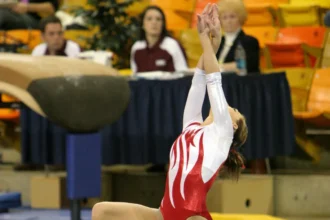The USA Gymnastics Women’s Development Program is divided into three major segments:
- Developmental Program (Levels 1–3)
- Compulsory Program (Levels 4–5)
- Optional Program (Levels 6–10)
The Optional Program is the only phase where routines are fully individually choreographed. Gymnasts build their own Start Values (SV) through a combination of skill difficulty and composition bonuses. While Levels 6–9 still have some skill restrictions in place to promote safety and progression, Level 10 is wide open, with no cap on difficulty.
In artistic gymnastics, the Optional Program refers to the competitive levels where gymnasts perform custom routines rather than standardized ones. Unlike compulsory gymnastics—where every athlete follows the same choreography—the optional levels allow gymnasts and their coaches to design routines that showcase their strengths, personality, and creativity.
What “Optional” Really Means
The word “optional” doesn’t mean that routines are optional to perform—only that gymnasts have the option to choose which skills to include. Gymnasts and coaches choreograph the entire routine: selecting skills, setting the order, designing the transitions, and, in the case of floor routines, even choosing the music.
There is no longer a national script to follow. Instead, judges assign a Start Value (SV) based on the skills performed. Higher-difficulty elements and connections raise the SV, up to a maximum of 10.0. The final score is calculated by subtracting execution, artistry, and composition deductions from that SV.
Levels 6–10: Overview and Progression
The competition path varies slightly by level, with each tier offering its own peak meet structure:
- Levels 6–7: Athletes compete at local and state meets. Some regions may offer a Regional Championship, but this is optional and decided at the regional level.
- Level 8: Gymnasts advance from local to state and then to Regional Championships. This is the final step for Level 8 to help limit travel and expenses.
- Level 9: Athletes move from local and state meets to regionals and can qualify for the Eastern or Western Championships, which serve as bi-coastal national-level competitions.
- Level 10: This level includes the full meet structure—local, state, regional—and culminates in the Development Program National Championships, the highest domestic competition before elite (usagym.org).
Where Optionals Live in the U.S. Development Program
The optional levels in the USA Gymnastics Women’s Development Program span Levels 6 through 10, with each level progressively increasing in difficulty and requirements. Here’s a quick breakdown of what each level includes:
| Level | Nickname | Special-Requirement Snapshot* | Typical Pathway |
|---|---|---|---|
| 6 | Intro Optional | 5 A + 1 B skills; capped at B value | Local → State |
| 7 | Advanced Beginner | 5 A + 2 B; limited C dance on beam/floor | Local → State |
| 8 | Intermediate | 4 A, 4 B, 0–1 C; first real bonus possibilities | Local → State → Regionals |
| 9 | Advanced | 3 A, 4 B, 1 C + up to 0.30 bonus; some D/E barred | Local → State → Regionals → Eastern/Western Championships |
| 10 | Pre-Elite | No skill caps; 0.50 bonus required for 10.0 Start Value | Local → State → Regionals → Development Nationals |
*For full special requirements, refer to the USA Gymnastics Optional Code of Points.
Age & Mobility Gates
All optional levels follow a consistent structure when it comes to age eligibility and mobility checkpoints. Gymnasts must meet both criteria before moving up the ladder.
- Minimum Age Requirements (as of December 31 of the competition year):
- Level 6: 8 years old
- Level 7: 9 years old
- Level 8: 10 years old
- Level 9: 11 years old
- Level 10: 11 years old
- Mobility Scores (All-Around):
- Level 5 → 6: 32.00 AA
- Level 6 → 7: 32.00 AA
- Level 7 → 8: 32.00 AA
- Level 8 → 9: 34.00 AA
- Level 9 → 10: 34.00 AA
These requirements are outlined in the USA Gymnastics Rules & Policies Manual.
How Optional Routines Are Scored
Unlike compulsory gymnastics, where every gymnast starts with the same 10.0 base score, optional routines are scored based on three main components:
- D-Score (Start Value): This includes all the elements factored into SV math—required value parts, special requirements, and bonus points. The Start Value is determined by the difficulty and composition of the routine.
- E-Score (Execution/Artistry): The execution score starts at 10.0 and is reduced for faults such as bent knees, poor form, balance checks, low amplitude, and lack of rhythm or artistry.
- Neutral Deductions: These are additional deductions not tied to performance quality, such as a fall (–0.50), overtime, stepping out of bounds, or attire violations.
Final Score Calculation
Final Score = Start Value + (10 – Execution Deductions) – Neutral Deductions
For example, a beam routine starting at 10.0 that loses 0.8 for execution errors and includes a fall would earn:
10.0 – 0.8 – 0.5 = 8.7
This scoring model rewards difficulty and clean execution while penalizing mistakes and missed connections, making routine construction and performance equally important.
How an Optional Routine Is Built
Designing an optional routine is both a strategic and creative process. Each level has specific requirements that shape how routines are constructed.
Value Parts: Every skill is assigned a difficulty rating from A (easiest) to E (most difficult). Each level requires a set number of these skills—for example, Level 6 requires five A-level and one B-level skill. Additionally, each routine must include four special requirements, each worth 0.5 points toward the Start Value (SV).
Start Value Math:
- The base Start Value starts at 9.5 for Levels 6–8, 9.7 for Level 9, and 9.4 for Level 10.
- Gymnasts can increase their SV by adding bonus points, which come from:
- Difficulty Bonus for including C, D, or E-level skills (Levels 9–10).
- Connection Bonus for smoothly linking specific skills together.
- At Level 9, gymnasts need 0.30 bonus to reach a 10.0 SV. At Level 10, the requirement increases to 0.50 bonus.
Composition Deductions: Judges may subtract points if a routine lacks variety or fails to meet composition guidelines. For example, repeating the same salto family, not using both directions on beam, or ending every bar element in a handstand could each result in 0.10–0.30 deductions. Well-designed routines highlight the gymnast’s strengths while minimizing exposure to weaknesses.
Optional Program as a Pathway
Level 10 optionals play a key role in preparing athletes for both collegiate and elite-level gymnastics.
To reach the elite level, gymnasts typically need to earn an All-Around score of 38.00 or higher at Development Nationals while also meeting specific elite mobility points. After that, they must pass additional testing through elite compulsory and optional verifications to qualify for competitions governed by the FIG Code of Points.
For college gymnastics, coaches actively scout Level 10 athletes by reviewing optional routine videos. They look for gymnasts who consistently demonstrate solid execution, competitive difficulty, and the potential to contribute to NCAA lineups.
In conclusion, optionals “live” in Levels 6‑10—the bridge between foundational technique and the unbounded artistry of elite and NCAA gymnastics. It gives athletes the freedom to grow beyond the basics and truly make routines their own.






